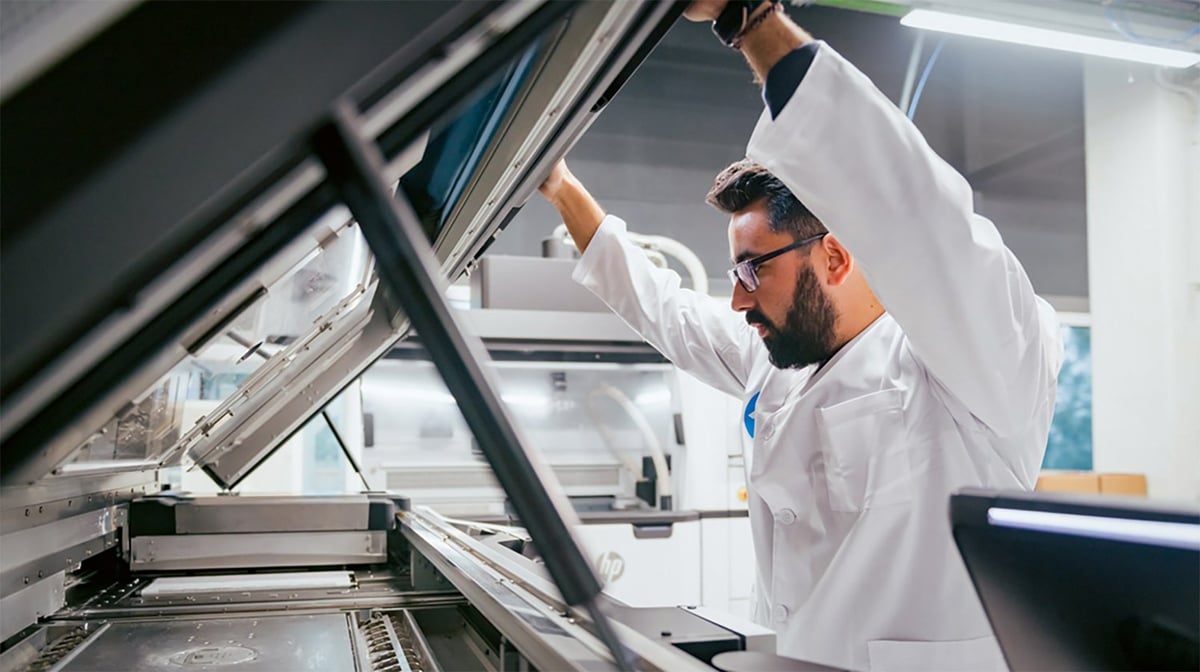HP Additive Manufacturing Solutions’ newest nylon powder for its Multi Jet Fusion (MJF) 3D printers, HR PA 11 Gen2, offers the highest nylon 11 reusability on the market, the company says.
At 80% reusability, the bulk of your powder from one print can be reused for the next, significantly reducing overall cost per part. Companies can expect a 40% part cost reduction using HR PA 11 Gen2 over HP’s older PA11 material, which was 70% reusable.
PA 11 material is based 100% on renewable raw materials and is characterized by high toughness as well as impact resistance and formability. Because nylon 11 is biocompatible, it’s the material of choice in the orthotics and prosthetics industry. In fact, HP says this new Gen2 PA11 is engineered specifically for orthotics and prosthetics applications, “providing comfort and durability essential for patient care.”
Nylon Put to the Test

Starting today at the American Orthotic and Prosthetic Association’s National Assembly in Orlando, HP is spotlighting case study examples of MJF use in orthotics and prosthetics.
In a recent pilot program, between the Limb Kind Foundation and HP Additive Manufacturing Solutions delivered five custom prosthetic devices to young patients in need in Kenya and Sri Lanka, using a fully digital, additive workflow and collaborating across continents.
The project began with on-site 3D limb scans conducted at the local hospital in Kenya. The collected data was then digitally transmitted to clinical and design teams in the U.S., who used HP’s Multi Jet Fusion technology to 3D print prosthetic sockets with customized fit and durability. The finished parts were shipped back to Kenya in under two days, accelerating delivery time by over 24 hours compared to traditional fabrication methods, according to HP. “In regions where prosthetic fitting can take up to a decade due to limited infrastructure, this approach offers a blueprint for scalable, fast and affordable care,” the manufacturer said in a statement.
Building on the success of that proof of concept, another initiative was deployed to Sri Lanka last month, where ten additional sockets were digitally fabricated and fit for local children using the same end-to-end workflow. Each deployment also included clinician training to establish local patient care capabilities.
HP’s Multi Jet Fusion technology addresses the core challenges of modern prosthetic care, HP says. “Unlike traditional fabrication methods, which are often labor-intensive and prone to waste, MJF delivers speed and consistency in a streamlined process. Importantly, its design flexibility also allows engineers to create lighter, more breathable devices, which is an essential consideration when working with pediatric patients.”
In the cases above, the MJF material used was HP’s PA12. The new HR PA 11 Gen2 will be available later this year.
Showcasing the End-to-End Digital Workflow for O&P

As part of its presence at AOPA, HP Additive Manufacturing Solutions (booth 1231) will host an interactive workshop showcasing the full digital workflow for producing patient-specific orthotic and prosthetic devices.
The workshop will walk through each stage of the process, including scanning the patient’s limb, designing the device with software, printing via HP’s MJF technology through a 3D printing service, post-processing, and final patient fitting. “This end-to-end, partner-driven workflow will highlight how personalized care can be delivered faster and more efficiently, while reducing complexity and waste,” says HP.












-1.png)


